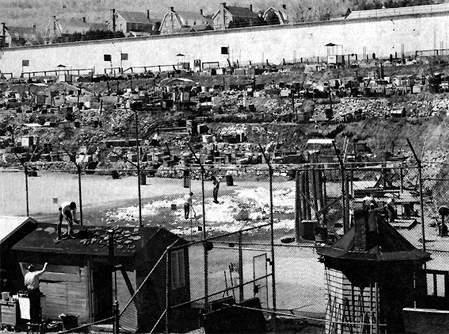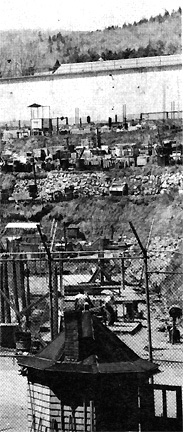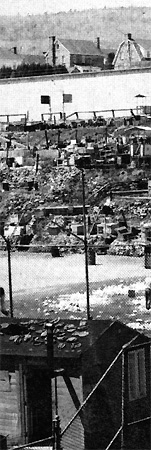
Right half of 1972 Clinton CF report photo showing field & courts from yard entrance.
(part 3: courts organization) |
||||||||
|
by Ron Roizen Every court has a manager and an assistant manager. Officially, the manager is the "owner" of the court, and he is responsible for infractions that may occur on it. In practice, it seems that this dominance is mellowed by the informal group processes of the members. Nevertheless, the manager has disproportionate power with regard to accepting new members, evicting current members, and shaping the activities of the court. Seniority is a major factor in becoming a manager. Courts are "inherited" in that they pass from one manager to the next on the basis of the pecking order of the court. Unless other factors obtrude in the process of leadership change (say, the heir does not want to be a manager, or another member asserts or suggests more leadership capacity or more capacity to improve the court welfare) the "succession" is left to the rank on a list of names that is kept by the yard sergeant. Thus, in terms of succession, each member has a defined status, Names are added to the bottom of the list when they join a court; members move up as the old guard is released, transferred, dies off, or is otherwise removed, This system of succession has several rather obvious functions.
There are other important functions of this system -- for example, its capacity to diffuse the leadership of the inmate population -- but these will be considered in our review of the functional position of the courts later in this report. This bare structure serves to establish something of a "household" among the members of a court. Within this household are certain activities. Cooking was inevitably one of the first mentioned. Anyone who has spent a considerable time alone knows that cooking and eating are often casualties of solitude. Food preparation and eating become fueling rather than a meaningful and pleasant activity. Meal-taking and the preparation of food are quintessentially social activities. In some cases, the preparation of food in the courts may become quite elaborate. But even when the fare is simple, the meals set in motion some of the social amenities. Eating alone and eating in huge mess halls are similar to the extent they bleach out the meanings of meal occasions. It should also be noted that institutional (in the everyday sense of that term) food is often somewhat foreign and unpalatable to some groups of inmates. Thus, for example, inmates of Puerto Rican identification are able to supplement their diets with their own food.
These are posted on a list of rules in the guard station and are brought to the attention of anyone in the process of becoming a court member. These rules can be used as something of a cipher for the problems brought about by the court institution. No system of explicit rules, in fact, objectively or exhaustively describes the operating procedures of a social institution.
The nine posted rules are suggestive of the institutional problems the courts pose or have posed in the past. Rule 1: Court numbers must be visible. The primacy of custody, and the necessity of the staff -- as in all emergency-type organizations -- to be "prepared for the worst" have several implications for the courts. Flat space, rectilinearity, and unambiguous locational coordinates make prison environments consonant with the needs for speedy, unambiguous, and highly rationalized action. This spatial factor is discussed in more length below. For the moment it is sufficient to observe that a numbering system for the courts became the halfway position between no "addresses" and a bulldozed plane of level, square plots. Rule 2: Courts [are] not to be traded or sold. This rule is an argument a forteriori for the value of the courts to some inmates. Selling and trading, however, also suggest several potentials for the disruption of the court system. One need merely think of a social institution called escrow to be reminded that the transfer of territory from one person to another involves many points for disagreement and dispute. That the courts have value virtually entails that their ownership, transfer, and control require structuring. There are probably some other important reasons for the sale stricture. In the first place, the inmate's departure from the statuses, powers, and influences held on the outside is a characteristic common to all total institutions. [#7] The allowance of a free market on courts would inevitably allow the control of these courts to gravitate toward the inmates with "external" power (derived from their "outside" statuses and resources) rather than from "internal" power achieved through seniority. This allowance would also run counter to the value placed on equal treatment of prisoners. Along with the abridgement of these values, moreover, come some rather practical considerations. If the rewards used by the institution to manipulate the inmate population were allowed to be purchased in "foreign" currency, the social control system would be threatened. "The rent for the courts," wrote Rodehaver et al, "is good behavior." [#8] Rule 3: Court managers cannot be changed without approval. Managership is the point of contact between the courts and the official authority. Thus, in some cases -- whether by election, collective decision, or the chance arrival of a particular individual to the top of a seniority list -- some inmates are not acceptable to the staff as their intermediary. This rule, then, is an insurance policy of sorts on the structure of succession. One gets the impression that it was rarely invoked since the inmates who pose sufficient problems to be barred from manager posts are the same as those who would lose seniority through sentences to the disciplinary unit. Further, known "troublemakers" are often shunned from the courts -- the existing manager may not want to risk responsibility for his acts and ill-fortunes Rule 4: Adding or removal of men must be approved. Same as above. One point that may be raised here, however, relates to the age old problem of monitoring -- allegedly for the rehabilitative benefit of the inmate -- his prison associations. The interviews revealed that an inmate will sometimes be barred from a court if it is known that the court to which he is applying includes his pre-prison criminal confederates. . . . Like many prison rules -- and public laws for that matter -- this rule lies ready and waiting should a perceived need arise. A second implication of this rule pertains to the responsibilities of the yard staff. In part a central necessity of the staff is the knowledge of how many prisoners are within one's immediate responsibility, if they are all there, and who they are. The court system poses a difficulty for this task, as does the yard. Thus, the court's register becomes an element in this objective. Knowing how many men are assigned to the courts, and where they are may be part of the guard's official role. In fact, a record of each inmate's history on the courts is kept at the tower of the yard sergeant. . . .
More mundane problems, additionally, spring from the fact that the creation of household-like groups brings in its wake certain conflicts between the customary activities of households and the uniform code of prison regulations. This is a wellspring of what might be called "technical deviance" that has required certain special compromises to be incorporated in the silent pacts between staff and inmates of Clinton prison. Rule 6: Illegal acts or goods on [the] courts will forfeit [the] courts. Catch 22. The key to this rule, I think, is that it gives official sanction for the staff prerogative to expropriate the real estate. Equally important is the sanctioning of the exercise of this prerogative on the group as a whole, rather than merely on individuals' rights to a court. The strategy of group or unit discipline is too well known to require further discussion. Rule 7: Absolutely no legal materials are permitted. The reason given for this rule provides a fine example of the conflict.that arises out of the separate realities of staff and inmates. The rule, first of all, means that the bringing to the courts (i. e. , the private plots of land) of legal documents pertaining to an inmate's case is proscribed. Until recently, New York law prohibited prisoners from helping one another on their legal appeals; work on one's own case was, however, allowed. The change in the State law may prompt a change in Rule 7, although some officers indicated that consultation may be permitted elsewhere in the prison, now, but not on the courts. . . . The rationale given to me for this rule, however, points up a structural conflict between the interests of the staff and the inmates. . . . The effective manipulation of inmates depends upon the ability of the staff to retain a monopoly on the reward system, such as it is. . . . Legal expertise is highly prized by many inmates. Thus, inmates with it may obtain indigenous rewards by their services. Such rewards are gotten independently of the social control interests of the staff, and therefore are perceived by them to weaken their hegemony . . . a threat to the prison's equilibrium. Rule 8: Each court must have an assistant manager. In the course of my visit nothing was mentioned of the role of the assistant manager. In all probability this rule merely served to clarify the succession and the hierarchy of the courts so that, in the absence of the manager, the responsibility for the court could be unambiguously attached to someone. I have no information on this point, however, and there may well have been more important reasons.
It is instructive to compare the staff rules to the inmate norms regarding the exclusion of a court member. In his 1957 study of the courts, Mancusi [#9] asked a sample of court members: "For what reasons might you drop or put off one of your court members?" Stealing on the court, homosexual acts, fighting and frequent arguments were the most frequent responses. The disparity between staff and inmate rules suggests that, while inmate norms serve to protect the court from internal strife and the threat of staff intervention and expropriation, staff rules may largely be accounted for in terms of maximizing social control through visual observation, the monitoring of membership, the legitimation of the inmate court hierarchy, the explication of eminent domain, and the monopolization of rewards. In short. the staff rules proscribe behaviors that would diminish their control and the inmate norms proscribe behaviors that would diminish their autonomy. This split in the transactional groundrules of the courts is important, and it will turn up later in our discussion of the courts functions and meanings. It is clear that the courts pose certain problems for the staff. We have suggested that in part these problems spring from the location-finding difficulties of irregular shape, the high potential for concealment of illegal acts or contraband, problem of "lost" inmates and the monitoring of inmate sociations, the creation of "valuable" property and the attendant threat of internecine conflicts. To be sure, there are payoffs for the staff from the courts. But the question that arises in our minds is how the courts came into existence and how they grew to the status of a legitimate institution. Some commentators have described the appearance of the courts as a "hobo" encampment; inmates may themselves refer to the courts as "the Jungle." The appearance alone, in other words, would tend to suggest that special factors and a gradual evolution may have been at work. Few administrators would create such a space by fiat or on the spur of the moment; additionally, there are several important prerequisites, which probably became available over time. Thus, we turn next to what can be gleaned about the history of the courts. The doors of inmate spaces in total institutions inevitably lock from the outside rather from the inside, if they lock at all. From the perspective of the staff, in other words, all inmate spaces are public. Thus, the inception and evolution of the courts is an important element in the analysis of the "deviant case" of private property in a total institution. |
| <-- previous | [parts list] | next ---> |



